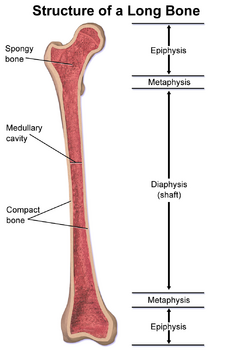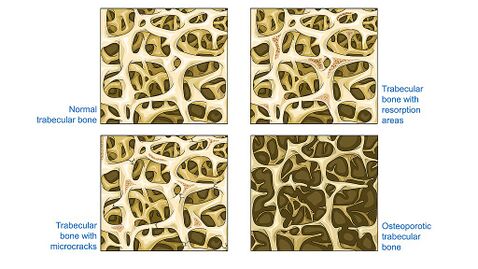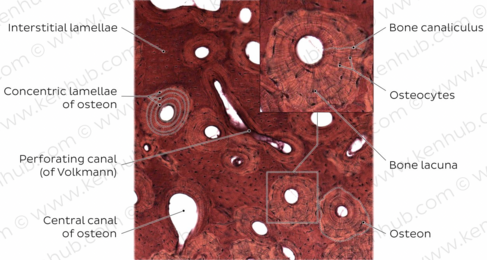Bone Cortical And Cancellous: Difference between revisions
No edit summary |
No edit summary |
||
| Line 1: | Line 1: | ||
<div class="editorbox"> | <div class="editorbox"> | ||
'''Original Editor '''- [[User: | '''Original Editor '''- [[User:Lucinda hampton|Lucinda hampton]] | ||
'''Top Contributors''' - {{Special:Contributors/{{FULLPAGENAME}}}} | '''Top Contributors''' - {{Special:Contributors/{{FULLPAGENAME}}}} | ||
</div> | </div> | ||
== Introduction == | == Introduction == | ||
Bones are divided into two macroscopic forms: cancellous bones and cortical bones. Cortical bones make up most of the skeletal system (up to 80%), while the rest is cancellous bones (roughly 20%).<ref name=":0">Radiopedia Cancellous bone Available:https://radiopaedia.org/articles/cancellous-bone (accessed 12.11.2022)_</ref> | [[File:Long Bone Structure.png|thumb|350x350px|Long Bone Structure]] | ||
[[Bone|Bones]] are divided into two macroscopic forms: cancellous bones and cortical bones. Cortical bones make up most of the skeletal system (up to 80%), while the rest is cancellous bones (roughly 20%).<ref name=":0">Radiopedia Cancellous bone Available:https://radiopaedia.org/articles/cancellous-bone (accessed 12.11.2022)_</ref> | |||
'''Lamellae Difference:''' The extracellular matrix of bone is composed mainly of type 1 collagen, these fibers adopting a preferential orientation in the human skeleton, resulting in the formation of lamellar bone (a thin layer of bone). | |||
The extracellular matrix of bone is composed mainly of type 1 collagen, these fibers adopting a preferential orientation in the human skeleton, resulting in the formation of lamellar bone (a thin layer of bone). In cortical bone, these lamellae are arranged concentrically around the Haversian systems | |||
# In cortical bone, these lamellae are arranged concentrically around the Haversian systems | |||
# In cancellous bone, they are parallel to one another.<ref name=":2">Science direct Cortical bone Available:https://www.sciencedirect.com/topics/medicine-and-dentistry/cortical-bone (accessed 12.11.2022)</ref> | |||
== Cancellous Bone == | == Cancellous Bone == | ||
| Line 16: | Line 19: | ||
* This bone has high porosity (> 70–80%) with more space than compact bone. The high surface area facilitates cancellous bone which have a higher metabolic activity compared to cortical bone, eg bone cell production and mineral exchange is higher in trabecular bone compared to cortical bone.<ref name=":2" /> | * This bone has high porosity (> 70–80%) with more space than compact bone. The high surface area facilitates cancellous bone which have a higher metabolic activity compared to cortical bone, eg bone cell production and mineral exchange is higher in trabecular bone compared to cortical bone.<ref name=":2" /> | ||
* The bone marrow of cancellous bones produces red blood corpuscles and white granular corpuscles.<ref name=":1">Difference between.com What is the Difference Between Cancellous and Cortical Bone Available:https://www.differencebetween.com/what-is-the-difference-between-cancellous-and-cortical-bone/ (accessed 12.11.2022)</ref> | * The [[Bone Marrow|bone marrow]] of cancellous bones produces red blood corpuscles and white granular corpuscles.<ref name=":1">Difference between.com What is the Difference Between Cancellous and Cortical Bone Available:https://www.differencebetween.com/what-is-the-difference-between-cancellous-and-cortical-bone/ (accessed 12.11.2022)</ref> | ||
* Although cortical bone is thought to bear the majority of the load in an individual bone, cancellous bone does contribute and serves to load share stresses out to the cortex.<ref>Encyclopedia of Bone Biology Available:https://www.sciencedirect.com/referencework/9780128140826/encyclopedia-of-bone-biology (accessed 12.11.2022)</ref> | * Although cortical bone is thought to bear the majority of the load in an individual bone, cancellous bone does contribute and serves to load share stresses out to the cortex.<ref>Encyclopedia of Bone Biology Available:https://www.sciencedirect.com/referencework/9780128140826/encyclopedia-of-bone-biology (accessed 12.11.2022)</ref> | ||
* Microscopically it is identical to cortical bone.<ref name=":0" /> | * Microscopically it is identical to cortical bone.<ref name=":0" /> | ||
| Line 29: | Line 32: | ||
# A bone marrow cavity is located in the centre of cortical bones, which stores fat.<ref name=":1" /> | # A bone marrow cavity is located in the centre of cortical bones, which stores fat.<ref name=":1" /> | ||
== | == Links == | ||
Take a delve into the links that interest you. | |||
[[Bone]], [[Mechanical Loading of Bone]], [[Bone Marrow]], [[Bone Healing]], [[Bone Density]] | |||
[[Fracture|Fractures]], [[Bone Stress Injuries]], [[Effects of Ageing on Bone]], [[Insufficiency Fracture]], [[Osteoporosis]], [[Bone bruise|Bone Bruise]], [[:Category:Bone - Conditions|Category:Bone - Conditions]] | |||
== References == | == References == | ||
<references /> | <references /> | ||
Revision as of 02:32, 13 November 2022
Original Editor - Lucinda hampton
Top Contributors - Lucinda hampton
Introduction[edit | edit source]
Bones are divided into two macroscopic forms: cancellous bones and cortical bones. Cortical bones make up most of the skeletal system (up to 80%), while the rest is cancellous bones (roughly 20%).[1]
Lamellae Difference: The extracellular matrix of bone is composed mainly of type 1 collagen, these fibers adopting a preferential orientation in the human skeleton, resulting in the formation of lamellar bone (a thin layer of bone).
- In cortical bone, these lamellae are arranged concentrically around the Haversian systems
- In cancellous bone, they are parallel to one another.[2]
Cancellous Bone[edit | edit source]
Cancellous bone is located in the medullary cavity of bone of tubular and short bones. It consists of dense trabeculae (struts), that traverse the bone marrow-filled medullary cavity, and are geometrically arranged to withstand local forces transmitted through the bone and are modifiable. Also known as spongy or trabeculae bone.
- This bone has high porosity (> 70–80%) with more space than compact bone. The high surface area facilitates cancellous bone which have a higher metabolic activity compared to cortical bone, eg bone cell production and mineral exchange is higher in trabecular bone compared to cortical bone.[2]
- The bone marrow of cancellous bones produces red blood corpuscles and white granular corpuscles.[3]
- Although cortical bone is thought to bear the majority of the load in an individual bone, cancellous bone does contribute and serves to load share stresses out to the cortex.[4]
- Microscopically it is identical to cortical bone.[1]
Cortical Bone[edit | edit source]
Cortical bone forms a protective layer around the internal cavity. Cortical bones high resistance to bending and torsion, making them able to bear the weight of the body. Also known as compact bone.
The key function of a cortical bone is in providing strength and protection to bones. Cortical bone is fairly smooth in comparison to a cancellous bone. The structure of the cortical bone consists of many layers.
- The most outside layer of the cortical bone is the periosteum, a two-layered structure. It serves to protects the nerves and blood vessels that run through the cortical bone. The interior layer of the periosteum consists of osteoblasts, which synthesize bone matrix.
- A bone marrow cavity is located in the centre of cortical bones, which stores fat.[3]
Links[edit | edit source]
Take a delve into the links that interest you.
Bone, Mechanical Loading of Bone, Bone Marrow, Bone Healing, Bone Density
Fractures, Bone Stress Injuries, Effects of Ageing on Bone, Insufficiency Fracture, Osteoporosis, Bone Bruise, Category:Bone - Conditions
References[edit | edit source]
- ↑ 1.0 1.1 Radiopedia Cancellous bone Available:https://radiopaedia.org/articles/cancellous-bone (accessed 12.11.2022)_
- ↑ 2.0 2.1 Science direct Cortical bone Available:https://www.sciencedirect.com/topics/medicine-and-dentistry/cortical-bone (accessed 12.11.2022)
- ↑ 3.0 3.1 Difference between.com What is the Difference Between Cancellous and Cortical Bone Available:https://www.differencebetween.com/what-is-the-difference-between-cancellous-and-cortical-bone/ (accessed 12.11.2022)
- ↑ Encyclopedia of Bone Biology Available:https://www.sciencedirect.com/referencework/9780128140826/encyclopedia-of-bone-biology (accessed 12.11.2022)









